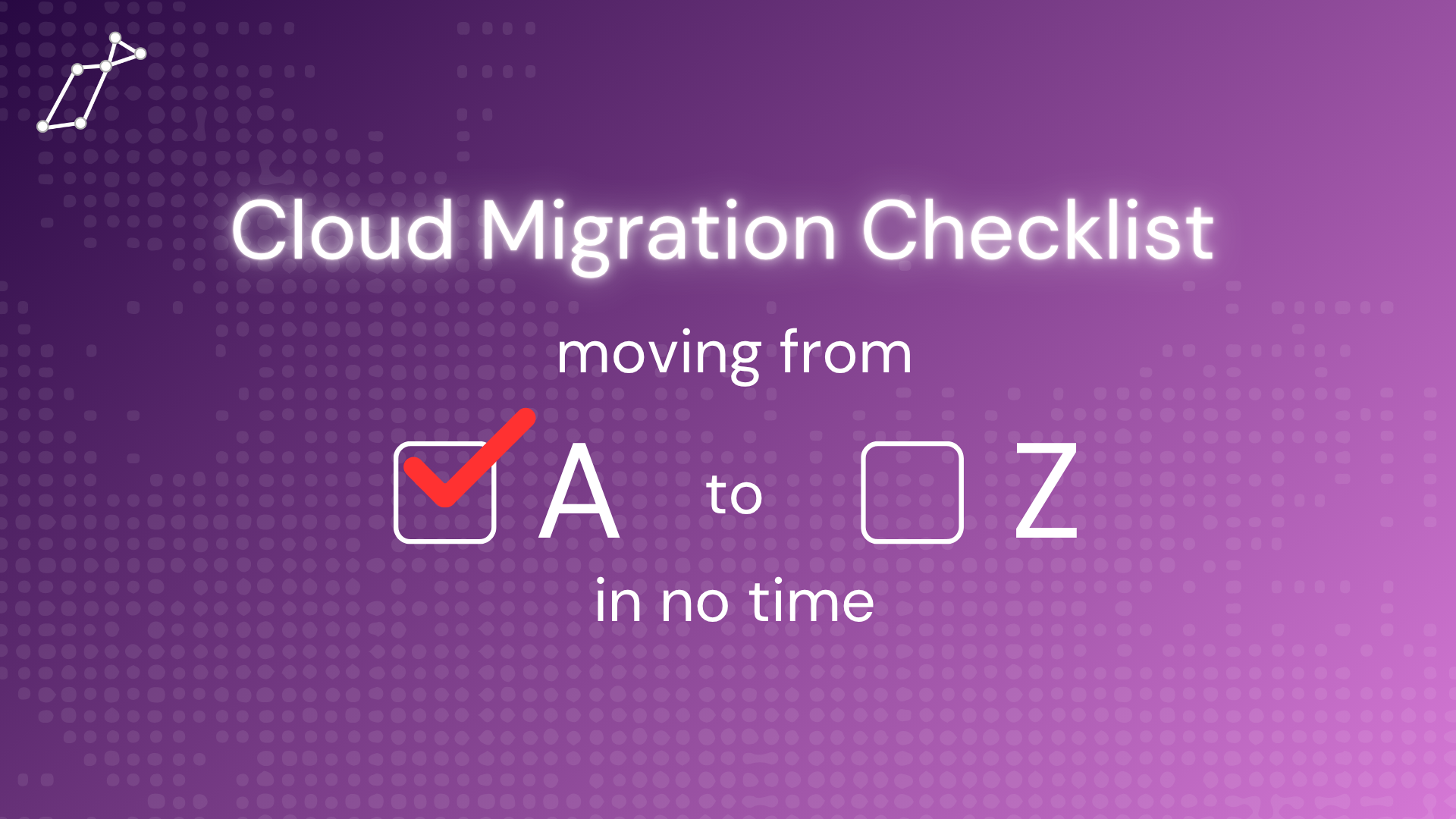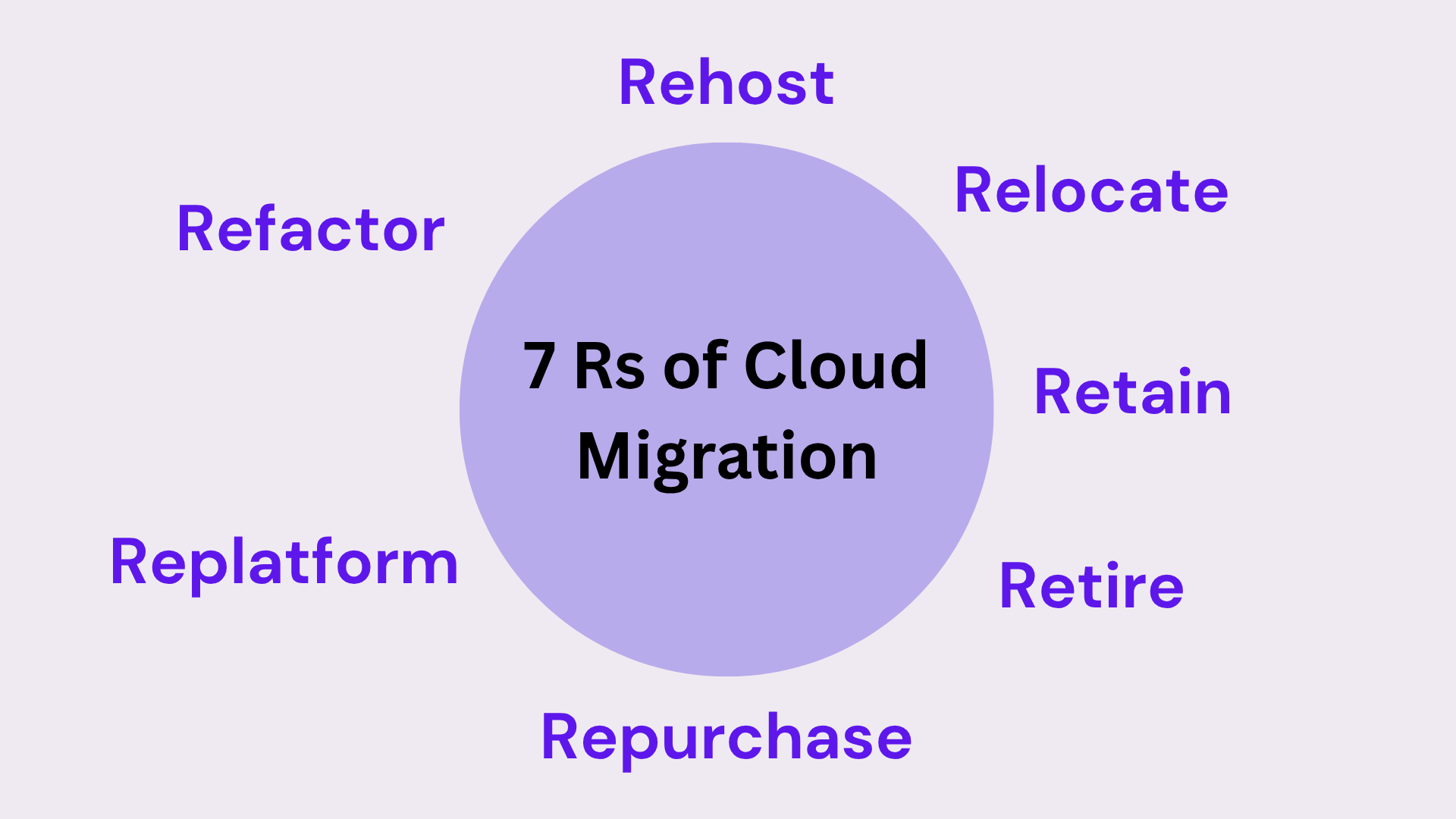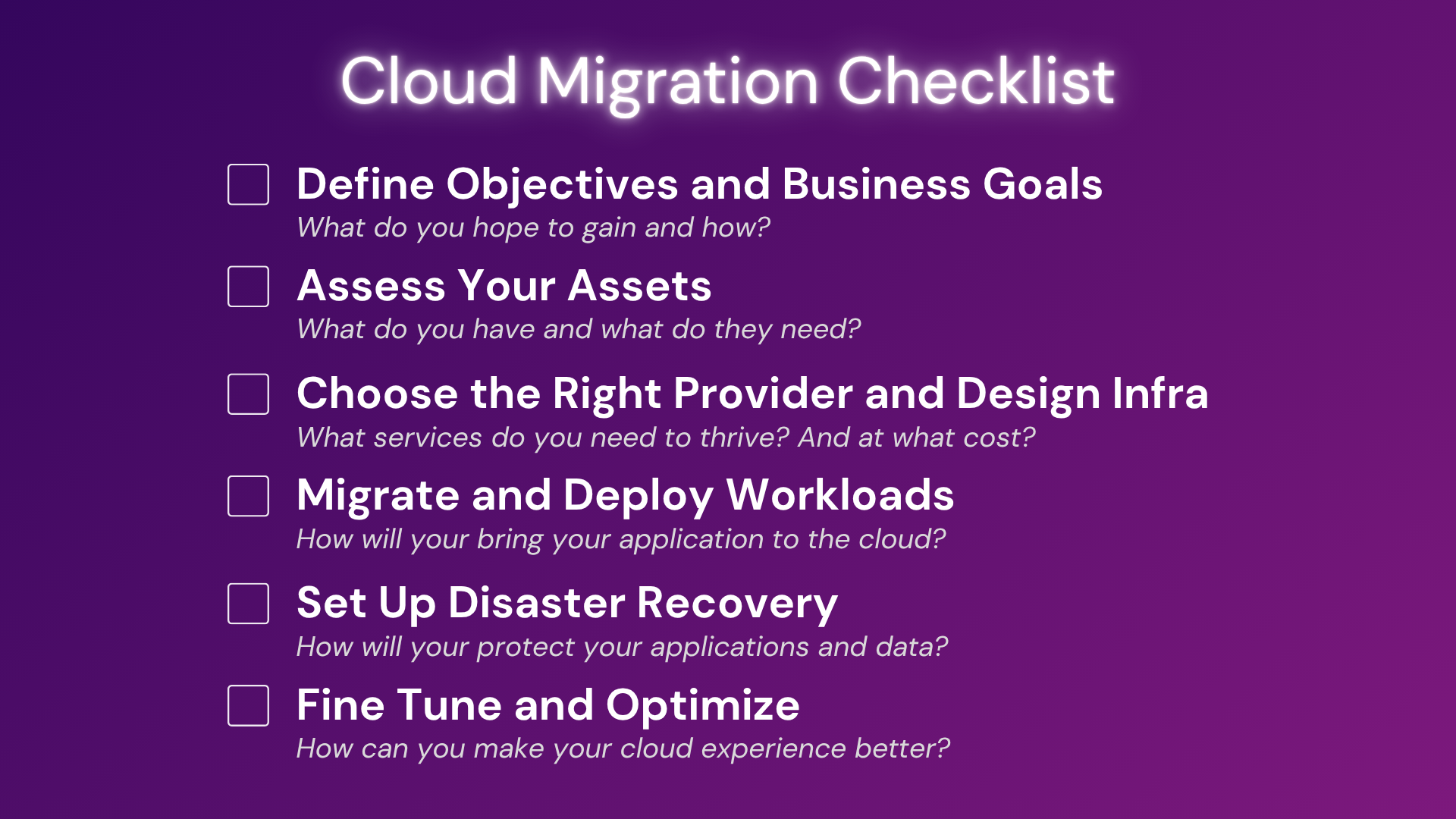Cloud Migration Checklist: Moving from A to Z in No Time



Why Use a Cloud Migration Checklist?
Grocery stores can be a slippery slope, depending on the price of course. At first you might be walking in with the intention to buy only eggs, but walk out with eggs, soda, pastries, and maybe even a new TV. Having a grocery list is critical in spending responsibly; the same can be said about having a strong cloud migration checklist.
It’s no secret that cloud computing has been the rage for quite some time now, but it’s also known that migrating to and operating within cloud computing can be confusing and even harmful to user applications and workloads. Many developers have had a hard time migrating to the cloud, and without a sound strategy or help, deploying within the cloud can just be a far away dream.
Cloud migration checklists exist to break down tangible cloud migration steps, everything from pre-migration assessment and options, to post-migration optimization and refinement. Cloud migrations checklists can be generalized at times, containing core steps that do not dive into the specifics that other lists do or that certain companies need.
While cloud migration is largely individualized, there are companies that offer migration services at a high cost. That being said, here are just some of the steps of cloud migration.
Migrating to the Cloud Checklist
Cloud migration involves moving applications, data, infrastructure, and more necessities from one environment to another, typically from on-premise to a cloud computing environment. Whether you’re looking to migrate onto a public cloud, private cloud, or even try your hand at a hybrid cloud approach, here is a cloud migration checklist that might work for you:
Define Objectives and Business Goals
Before migration planning, it is important to step back and think about what you’re looking to accomplish. What do you hope to gain from migration? Will downtime be worth the investment down the line? Will cloud computing be futureproof?
Business goals are objectives highly dependent on your own company’s mission; creating goals that are measurable and accepted within your organization will be key to a successful migration and after-migration processes.
Assess Your Assets
Now that you have stepped back and formed your cloud migration goals, step back in and assess your tech stack and applications.
Analyze the applications and workloads you plan on migrating to the cloud and document information relevant to these assets. Important information can include user information, resource requirements, user capacity, and tech stack involved. In addition, for backend applications, it can help to create a list of your applications and how often you use it. In some cases getting a new enterprise service could be more beneficial than migrating.
Knowing your applications and workloads inside and out can also help you set up necessary security within a new cloud environment and can help with performance benchmarking.
Choose the Right Provider and Design Your Infrastructure
You have your goals, you have your applications and workloads in mind, now it is time to choose where you’re moving and what you’re hosting on.
There are tons of different environments to host your applications or workloads on. From public and private cloud to a hybrid cloud experience that combines on-premise machinery (although this guide revolves around migration to the cloud), your choice in the environment is key to making or breaking your cloud experience. Equally as important is your choice in hosting; do you need an infrastructure that is highly scalable and hosts a variety of different data storage options, or one that is cheaper and straightforward.
With a new environment comes new data centers that house your precious data. Data center locations have different regulations and compliance requirements, as well as different machinery and pricing. Be sure to work with cloud providers that offer the best access and pricing to data center resources, though this is easier said than done.
Lyrid offers a global network of local data centers to deploy and host on, giving you the freedom to customize your cloud environment and experience to your liking. Learn more about Lyrid cloud hosting here: https://www.lyrid.io/
Migrate and Deploy Workloads
There are many ways to go about migrating your applications and workloads. Most experts recommend migrating in stages, executing each application and workload and seeing what sticks and what does not. However, this approach might not work for all migrations, leading to the creation of the 7 Rs of Cloud Migration.
The 7 Rs are common migration strategies, typically on a larger scale, but applicable to migrations of any size. They are as follows:
- Rehost: Also known as lift and shift, this strategy involves redeploying workloads onto cloud instances, typically with the help of cloud Infrastructure-as-a-Service (IaaS).
- Relocate: Transferring servers that host applications from an on-premise platform to a cloud version of that same platform.
- Retain: Strategy for applications that you want to keep in their original environment or for applications that you are not ready to migrate, suitable for companies looking towards a hybrid cloud approach.
- Retire: Decommission or archive applications that will not be migrated, as they provide no business value and can be costly to maintain and host.
- Repurchase: Also known as drop and shop, this strategy involves replacing your application with an entirely new product or an updated version of your application, providing more business value and requiring no infrastructure to maintain.
- Replatform: Strategy that involves migrating your application as normal, and optimizing to reduce costs and take advantage of cloud features
- Refactor: Moving your application and modifying its architecture using cloud capabilities to encourage scale, flexibility, and cost reduction
With these strategies, it is important to be cognizant of application and workload requirements, with careful planning playing a huge role in successful migration.

Set Up Disaster Recovery
As much as migrating to the cloud can be exciting, it is also dangerous if done wrong. Time and time again, developers have reported losing valuable data and even entire applications due to misconfigured migration or technical issues. Preparing accordingly is key to a successful migration, with disaster recovery and backups acting as a safety net.
Developing a strong disaster recovery plan should be your first step, with mandatory actions being to implement backups and data replication before migration is attempted. This preparedness extends to post migration processes as well.
Be sure to design your cloud infrastructure to be highly redundant and available, with regular disaster recovery and backup testing being mainstays in your maintenance schedule.
Fine Tune and Optimize
Migration is just the start of your cloud experience, be sure to monitor your application and workloads, specifically within cloud resource usage and costs. Cloud can become costly if unmanaged, with some of the biggest cost drivers also being the most hidden. Despite this, cloud computing is a great resource for companies looking to modernize, with automation and autoscaling being some of the best features about cloud.
While this cloud migration checklist is a good representation of general steps, it is important to adjust accordingly based on your own business needs and objectives.

Cloud Migration Challenges
As mentioned, cloud migration can be harmful to your applications and data, even going so far as to wipe both of them out if handled incorrectly. Some of the biggest challenges include:
Lack of Strategy
Even though we spent a majority of this blog emphasizing the importance of having a cloud migration strategy or checklist to act as a roadmap, there have been plenty of developers and organizations rushing in to migrate without a solid plan in mind.
The fact of the matter is, cloud might not even be the best option for you. While it is shiny and new and talked about, many organizations do just fine without cloud computing. That being said, some applications and workloads might even perform worse within the cloud, with careful assessment of applications being a key part of cloud migration.
If cloud migration is the best route for you, a lack of strategy can lead to shock and amplify some of the cons of migration, including costs and downtime. With a goal and strategy in mind, you are able to minimize the effects of cloud migration, pushing your organization to stronger cloud adoption.
Costs
It is no secret that cloud computing is expensive, with migration costs being one of the most frustrating aspects of this process. The process of moving applications and data itself is costly, including everything from new network connectivity and egress costs from another cloud. Costs also extend to post-migration cloud operation, with running workloads in cloud environments having a large impact on your IT spend
Organizational Adoption
Migrating to the cloud is one thing, preparing your team for brand new tech, processes, and more is another. Be sure that everyone is on the same page and ready to adopt and even learn new tooling. Another challenge on this front may be hiring cloud experts to streamline organization-wide cloud adoption while your team picks up cloud tooling.
Data Transfer Risks
Any large transfer or migration incurs a ton of risk, especially if sensitive data transfers between environments are involved. Choosing a cloud service provider with strong security and backup features is instrumental to your cloud migration success, with tools, practices, and security compliance being offered.
Cloud Migration with Lyrid
Whether migrating to the cloud will yield a strong ROI for your business, or you simply want to see what all the cloud buzz is about, having a cloud migration checklist is a great way to get your cloud journey started. From assessing your current assets, to backing them up, to even optimizing them post-migration, our cloud migration checklist has the steps necessary to migrate.
While a checklist and a proven migration method can lead you on the right path to a successful cloud migration, some developers and organizations can agree that it is simply not enough at times!
Lyrid helps migrate your precious data and services from your current cloud provider or on-premise environment onto Lyrid infrastructure! With our engineering support plan, we help any organization move from monolithic development into a microservices support cloud infrastructure, offering features such as:
- Seamless database migration with minimal downtime
- Data security
- Tailored migration process
- 24/7 support
- Integration with Lyrid cloud services
- Local data centers that ensure security and compliance
And so much more!

Looking to learn more? Visit https://www.lyrid.io/database-migration











